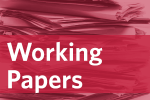Latest Research
Algorithmic Governance: The Case of Decentralized Exchanges on Blockchains

This project studies how algorithmic governance affect economic coordination in the context of blockchain-based organizations. Specifically, the project studies the algorithmic governance structures adopted among decentralized exchange protocols deployed on blockchains. The project documents and develops frameworks to understand variation in the kinds of structures adopted. In addition, the project examines how the adoption of ...Read More
Back to the familiar? How attention and rare experiences overcome local search in external technology sourcing.

In this paper, we develop and test a theoretical framework that considers how established firms forming partnerships with startups may be subject to spatial and temporal myopia and how these tendencies are moderated by the established firms’ histories of experiencing essential failures and successes in solving R&D problems. Read More
Leveraging Analytics to Maximize Innovation

Academics and practitioners will log onto an intuitive user interface and type in features of their own company (e.g., its size and industry). They will immediately be greeted with an “instant meta-analysis” that summarizes decades of academic findings related to the most important predictors of creativity and innovation in organizations. Read More
The Impact of Healthcare Price Transparency Rules

The US government recently required healthcare price transparency from hospitals and insurers in an attempt to control spiraling healthcare costs. On the one hand, price transparency and online search tools have been very effective in increasing competition for other products in the e-commerce space. On the other hand, healthcare is a complex product, often bought ...Read More
Examining the Role of Local Boards of Health in Local Health Departments in the United States

Nearly 3,000 local health departments (LHDs) across the United States are tasked with improving, maintaining, and monitoring population health. LHDs are an administrative or service unit of local or state government concerned with health, and carrying out the responsibility for the health of a jurisdiction smaller than a state. Read More
Strategies For Creating Value in Base of the Pyramid Markets: Evidence From a Field Experiment in India

In contexts with high poverty, impact-driven for-profit firms often take market-based approaches to drive inclusive growth while being financially sustainable. Even with the alignment between “doing well” and “doing good” that these firms supposedly seek to achieve, successful business strategies in these contexts have been associated with breadth of reach (reaching maximum number of beneficiaries) ...Read More
Silence Helps Men but Hurts Women: The Differential Gender Effects of Silence in Negotiation

Current literature consistently shows a gender gap in people’s performance in negotiation. In this research, we aim to use a GPT Negotiation Bot to understand whether men and women may be perceived differently when they use silence — a common and important conversation strategy — in negotiation. Read More
How Corning Leverages Its Organizational Memory to Create New Industries

Rahul Kapoor, Management, The Wharton School Abstract: The objective of this project is to document the history of Gorilla Glass―a material developed by Corning (formerly Corning Glass Works) that enables the touchscreen devices of the 21st Century. Corning started developing the predecessor technologies to Gorilla Glass in the 1960s, discontinued the development in 1971, resumed development in ...Read More
The Placeholder Effect: Using Break Days to Help Form Habits

This research aims to test a novel intervention to help people form healthy habits, such as exercise more. In particular, we will examine how encouraging people to have “placeholders” on their break days, or days off from pursuing their goals, affects their likelihood of reaching their goals. Read More
Work From Home: Who Gains and Who Does Not?

In this study, considering the benefits and costs of WFM, we consider two questions: (1) who has an incentive to work from home, (2) how is team coherence and work performance impacted when individuals work from home? Read More



